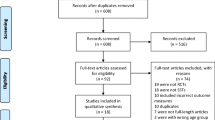Abstract
We implemented functional communication training (FCT) with a child with Pervasive Developmental Disorder-Not Otherwise Specified (PDD-NOS) who exhibited challenging behavior when preferred toys were removed. Prior to FCT sessions the participant was exposed to 15 min of access to the toys that maintained challenging behavior versus no access. The presession access versus no access conditions were systematically evaluated using an alternating treatments design. Results indicate that presession access to the toys was associated with a decrease in challenging behavior and an increase in independent communication during FCT training. Future research should attempt to replicate these procedures with other participants who exhibit challenging behavior.


Similar content being viewed by others
References
Carr, E. G., & Durand, V. M. (1985). Reducing behavior problems through functional communication training. Journal of Applied Behavior Analysis, 18, 111–126.
Fisher, W., Piazza, C., Cataldo, M., Harrell, R., Jefferson, G., & Conner, R. (1993). Functional communication training with and without extinction and punishment. Journal of Applied Behavior Analysis, 26, 23–36.
Lang, R., O’Reilly, M., Sigafoos, J., Lancioni, G. E., Machalicek, W., Rispoli, M., et al. (in press). Enhancing the effectiveness of a play intervention by abolishing the reinforcing value of stereotypy for a child with autism: a pilot study. Journal of Applied Behavior Analysis.
Mancil, G. R., Contory, M. A., Nakao, T., & Alter, P. J. (2006). Functional communication training in the natural environment: a pilot investigation with a young child with autism spectrum disorder. Education and Treatment of Children, 29, 615–633.
McGill, P. (1999). Establishing operations: implications for the assessment, treatment, and prevention of problem behavior. Journal of Applied Behavior Analysis, 32, 393–418.
Michael, J. (1982). Distinguishing between discriminative and motivational functions of stimuli. Journal of the Experimental Analysis of Behavior, 37, 149–155.
O’Neill, R. E., & Sweetland-Baker, M. (2001). Brief report: an assessment of stimulus generalization and contingency effects in functional communication training with two students with autism. Journal of Autism and Developmental Disabilities, 31, 235–240.
O’Reilly, M. F., Sigafoos, J., Edrisinha, C., Lancioni, G., Cannella, H., Choi, H., et al. (2006). A preliminary examination of the evocative effects of the establishing operation. Journal of Applied Behavior Analysis, 39, 239–242.
O’Reilly, M. F., Edrisinha, C., Sigafoos, J., Lancioni, G., Machalicek, W., & Antonucci, M. (2007). The effects of presession attention on subsequent attention-extinction and alone conditions. Journal of Applied Behavior Analysis, 40, 731–735.
O’Reilly, M. F., Sigafoos, J., Lancioni, G., Rispoli, M., Lang, R., Chan, J., et al. (2008). Manipulating the behavior-altering effect of the motivating operation: examination of the influence on challenging behavior during leisure activities. Research in Developmental Disabilities, 29, 333–340.
O’Reilly, M. F., Lang, R., Davis, T., Rispoli, M., Machalicek, W., Sigafoos, J., et al. (in press). A systematic examination of different parameters of presession exposure to tangible stimuli that maintain challenging behavior. Journal of Applied Behavior Analysis.
Reichle, J., & Wacker, D. (1993). Communicative alternatives to challenging behavior: Integrating functional assessment and intervention strategies. Baltimore: Brookes.
Rispoli, M., O’Reilly, M., Lang, R., Machalicek, W., Davis, T., Lancioni, G., et al. (in press). Effects of motivating operations on aberrant behavior and academic engagement in classrooms. Journal of Applied Behavior Analysis.
Schopler, E., & Reichler, R. J. (1980). Toward an objective classification of childhood autism: childhood autism rating scale (C.A.R.S.). Journal of Autism and Developmental Disorders, 10, 91–103.
Sigafoos, J. (2000). Communication development and aberrant behavior in children with developmental disabilities. Education and Training in Mental Retardation and Developmental Disabilities, 35(2), 168–176.
Sparrow, S. S., Balla, D. A., & Ciccheti, D. V. (1984). Vineland adaptive behavior scales. Circle Pines: American Guidance Service.
Acknowledgements
The authors would like to thank the Capitol School of Austin.
Author information
Authors and Affiliations
Corresponding author
Rights and permissions
About this article
Cite this article
Davis, T.N., O’Reilly, M.F., Kang, S. et al. Impact of Presession Access to Toys Maintaining Challenging Behavior on Functional Communication Training: a Single Case Study. J Dev Phys Disabil 21, 515–521 (2009). https://doi.org/10.1007/s10882-009-9158-4
Published:
Issue Date:
DOI: https://doi.org/10.1007/s10882-009-9158-4



